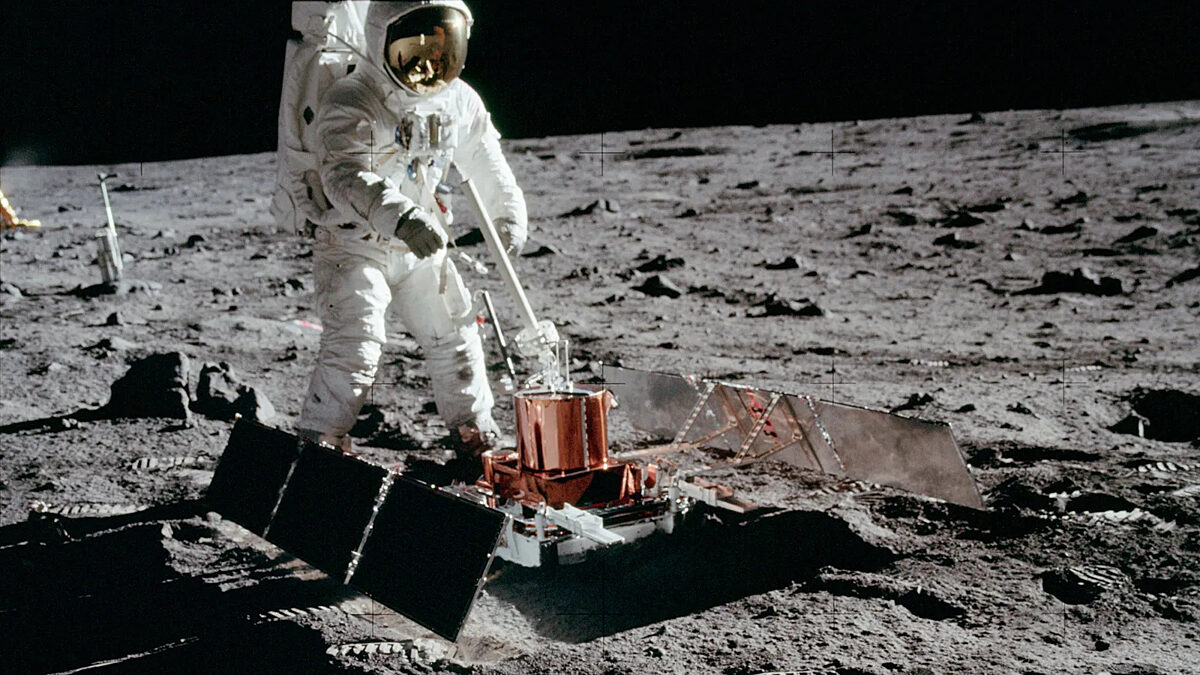The Downlink • Mar 29, 2024
Keeping an eye on things
Space Snapshot

The Moon is shrinking, a phenomenon we understand in part due to experiments like the one seen here being placed on the Moon by an Apollo 11 astronaut. The experiment, called the Passive Seismic Experiment seismometer, measured moonquakes — evidence of the Moon’s surface crinkling as its interior cools and contracts. The Moon isn’t just shrinking in volume; it’s also getting farther away. Image credit: NASA.
Fact Worth Sharing

Because the Moon is getting smaller in our skies, total solar eclipses won't go on forever. In about 620 million years, they'll only happen when the Moon is at its closest point to Earth in its elliptical orbit. The last total solar eclipse will occur in about 1.2 billion years.
Mission Briefings


NASA has announced the science instruments for Artemis III. When astronauts return to the lunar surface, they’ll bring three scientific instruments with them, NASA announced this week. Astronauts will deploy these instruments to study moonquakes, the surface environment’s effects on space crops, and the lunar regolith’s ability to propagate an electric field. Pictured: The lunar south pole, where Artemis III astronauts will land and deploy instruments, imaged by NASA's Clementine spacecraft. Image credit: NASA/JPL/USGS.

Europa Clipper is well-equipped to search for life. New studies suggest that even a tiny fraction of cellular material could be identified by the kind of mass spectrometer that will be onboard NASA’s Europa Clipper spacecraft, which is set to launch this year for Jupiter’s icy moon. This increases the chances that the mission will be able to detect life if it does indeed exist in Europa’s subsurface oceans.

The Odysseus lunar mission is officially over. The privately-developed spacecraft, which landed on the Moon on Feb. 22, did not survive the lunar night. Intuitive Machines, the company that built Odysseus, can still celebrate the mission’s overall success in becoming the first American spacecraft to land on the Moon since the Apollo program.
From The Planetary Society


It’s definitely worth keeping an eye on the Sun (figuratively). Although we don’t recommend looking at the Sun yourself, it’s extremely important that we Earthlings monitor and understand the Sun’s activity. As our star reaches the peak of its activity cycle, the danger of a major solar storm — which has the potential to cause blackouts, disable satellites, and wreak other havoc — is now at its highest in over a decade. Learn more about solar storms, what we’re doing to understand them, and how we could mitigate their effects. Pictured: This split image shows the difference between an active Sun during the April 2014 solar maximum (left) and a quiet Sun during the December 2019 solar minimum (right). Image credit: NASA/SDO.

Direct your eyes this way! We’ve got a new batch of the coolest space pictures from the past month. This month features human spaceflight, Jupiter’s storms, a Martian transit, and more.

We’re watching NASA’s budget, and so should you. The Biden Administration released its 2025 budget request for NASA on March 11, 2024, and it’s not enough. Planetary Society Chief of Space Policy Casey Dreier explains what the budget includes, what it’s missing, and what you can do to fix it — including registering for our Day of Action to meet with your representatives in Washington, D.C., and advocate for space.

Let's talk about the books that put the "science" in "science fiction!" Andrew Fraknoi, an esteemed astronomer, educator, science communicator, and author, recently joined Planetary Society members in an online Q&A to discuss his curated selection of new and classic science fiction tales that adhere to science. Watch a recording of the event here.
What's Up

Very bright Jupiter stands out in the evening eastern sky, shining brighter than any nighttime star, with Mercury lower in the sky to the west. In the predawn, look for reddish Mars in the east.
Whether you’re looking up or tuning in, get ready for the eclipse!

If you’ll be in the path of the April 8 total solar eclipse, download our official eclipse app, made in partnership with The Eclipse Company, to help you find the best spot to watch. If you’re not in the path, you can still share in the wonder and excitement by tuning in to our Eclipse-O-Rama 2024 live stream, featuring special guests Everyday Astronaut, Mark Rober, Bill Nye, and more. And if you want to brush up on your eclipse knowledge before the big day, check out a preview of our online course all about solar and lunar eclipses.
Wow of the Week

In 1859, English astronomer Richard Carrington was observing the Sun with a solar telescope when he noticed a particularly large grouping of sunspots. He documented his observations in a drawing (pictured). These sunspots were far from ordinary; they were part of a series of outbursts from the Sun that soon caused the strongest geomagnetic storm in recorded history, now known as the Carrington Event. Image credit: Richard Carrington.
Send us your artwork!
We love to feature space artwork in the Downlink. If you create any kind of space-related art, we invite you to send it to us by replying to any Downlink email or writing to [email protected]. Please let us know in your email if you’re a Planetary Society member!


 Explore Worlds
Explore Worlds Find Life
Find Life Defend Earth
Defend Earth

